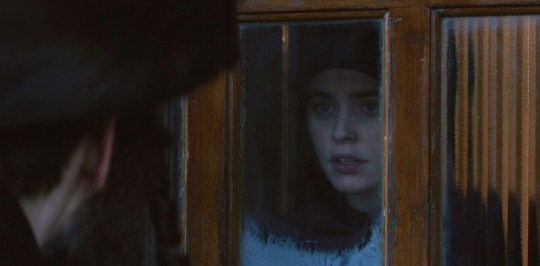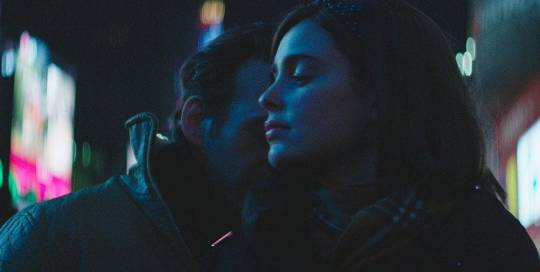#martin dubreuil
Photo
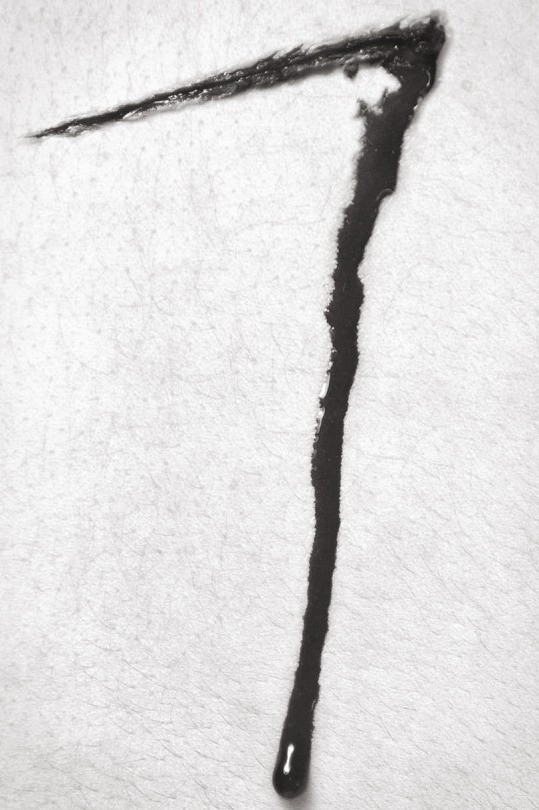
Jusqu'où iriez-vous pour vous venger ?
Jusqu'au bout de l'univers. Je ferais tout ce qui doit être fait... et plus encore.
#7 days#les 7 jours du talion#patrick senécal#claude legault#rémy girard#martin dubreuil#rose-marie coallier#fanny mallette#daniel grou
4 notes
·
View notes
Text
Apologies for the wait again my dear @micheleamidalajedi My brain didn't want to co-operate then I got all nervous about doing something I don't know anything about. After some googling I came up with this. I haven't proof read it because I will talk myself out of posting it. I hope it's okay. Thank you for your patience.
Alex Law x reader.
This was the third time this week he had come in to the restaurant. Business wasn't exactly booming so it was easy to keep track of faces. A high end vegan restaurant is kind of a tough sell in this economy, maybe it would have sold better to the hip crowd in London.
"You can serve him." Christine all but shoved you from behind the bar.
"Why me? I'm busy!" The glasses you were putting back on the shelf almost went tumbling as she dragged you away to steer you towards him.
"I've served him twice. Mark's served him once. He's just a bit..callous. I don't think he thinks before he speaks, he just wants what he wants. Definitely new money, probably just excited to spend it but it's a pain in the arse." He explained hurriedly under her breath.
"Oh, well, then of course I'll serve him!" You huffed back.
"You really haven't noticed have you? The way he waits until you are close to his table to leave so he can say goodbye? The way his eyes follow you? He likes you!" She looks shocked that it hadn't occurred to you.
When you look over at his table he is indeed smiling at you. Your hand comes up of it's own accord to give him a little wave. Christine glares at you, her point proven.
"Fine. I'll serve him." You concede.
"Good evening, Sir. Thank you for dining with us. Would you like to hear tonight's specials?" You slip into you script.
"No, thank you. I know exactly what I would like to have..." he wants what wants, you could see Christine's problem. He was polite, said 'please' after every request. Most of his order was pretty standard, very popular starter and main, it was the desert that caught your attention "....and for desert I would like the Decadence D’Or Cupcake please." The Decadence D’Or Cupcake was created by chef, Olivier Dubreuil at the Palazzo in Vegas. Like you would expect from something created in Vegas it was completely over the top. Made from Venezuela’s rare Porcelana Criollo bean, topped with Tahitian Gold Vanilla Caviar and edible gold flakes. It also includes Louis XIII de Remy Martin Cognac and comes in a hand blown sugar Fleur-de-Lis. Each cupcake cost £500! Your rent for the month!
"Very good choices, Sir. Can I get you anything while you wait?" You tapped at your iPad as you spoke. Instantly sending his order to the kitchen.
"No...but could I ask you a question? I'm Alex by the way." He held out his hand, you shook it and gave him your name, tapping your name tag as you did.
It was a little usual but he was one of two customers here tonight so there was no trouble in indulging him. "Sure."
His smile widened. "Which of the following figures do you most closely identify: Joan of Arc, Eva Braun, or Marilyn Monroe?"
"Well that is a question and a half!" You jaw had dropped slightly.
"I find it helps to get to know people and I'd like to get to know you." His smile was almost shy, despite him coming off as the most confident man in the world. It looked charming on his handsome face.
Your answer was interrupted by his order being ready. A simple salad took the three chefs working no time to prepare. When you returned he thanked you before looking up expectantly.
"If I give you an answered, will you promise not push for an explanation?" If he wasn't already intrigued but you those words had him hooked. The journalist in him smelled a story. Pushing that instinct down he reassured you he wouldn't.
"Joan of Arc." You replied with smirk. It was a little twisted, your own private joke about your scars. The burns that littered your arms, chest and neck, were covered by your dress.
Alex ate his starter and main conversing with you when he could. When you brought his eye wateringly expensive desert out he asked another question. "Have you tried it?"
"No." You laughed. "They are a little out of my price range."
Picking up the knife on the table he quickly sliced it in two. "You should. Join me?"
Looking around, trying to gauge if you would get in trouble you realised that that other customer had left, your colleagues were now all gathered at the serving window, watching intently. As you slowly slipped into the chair opposite Alex, they all gave you the thumbs up. The cupcake was excellent. Moist and flavourful. The best part was Alex's face it lit up joyfully. He savoured every bite. It made you smile.
It was then you decide to write your number on his receipt. He called the next day and the next time you ate together, your weren't the one serving. You talked about anything and everything. Alex was smart, witty, endlessly curious. He was also sweet and respectful. He never comment led on your clothing. Everything you wore had a high neck and long sleeves. You'd long since tired of the gawking of strangers. Even when he had eventually stayed over, he hadn't made a deal of your scars or the story behind them. Even though you knew his mind itched with questions.
The next morning, you stood looking out of the window with your coffee in your hand. Alex came out of the bathroom to see you standing there, bathed in the light. He was wearing his clothes from last night, you had thrown on a tank top.
"May I?" His hand hover over your arm. You weren't sure what he was asking but you nodded anyway. His finger tips gently traced the uneven skin. You gasped at the tenderness. His feather light touch sent shivers up your spine. It had been years since you had be touched with such care and reverence. It made your heart swell.
"I know it's none of my business and you probably tire of questions about them but I think you are truly stunning. You shouldn't feel the need to hide." As if to emphasise his point his lips trailed behind his fingers. He placed kisses all the way up your arms and back. They were soft yet firm, full of meaning. You are beautiful, believe me. He was right, of course. You shouldn't have covered up just for a quite life. If people wanted to stare, it said more about them than about you.
The weather was warming, so once Alex left you went out to buy yourself some summer dresses. When your wore one that night, his lips return to your exposed skin. "I'm proud of you. You should never let anything hold you back from living life the way you want to live it." That very much seemed to be Alex out look on life. You started spend all your free time together. Yet you still hadn't been to Alex's place. He put it down to his roomate David 'having a hard time.' Not wanting to pry you didn't mention it again. Alex stayed at your place only going back to his when he needed. Like now, you sat on your couch, flicking through the channels finally settling on The Crystal Maze, while you waited.
A hurried knock at your door, drew your attention. Opening it you found Alex outside with two suitcase. "How to do you feel about Rio?"
5 notes
·
View notes
Text
youtube
Jérôme Minière "Ta maison à Cuba" (sur les images du film de Pedro Ruiz)
composé, arrangé et interprété par Jérôme Minière
comédien: Martin Dubreuil
extrait de l'album "Le huitième étage, jours de révolte (bande originale du film)"
disponible sur toutes les plateformes numériques depuis le 23 février 2024
lien vers les plateformes: https://bfan.link/le-huitieme-etage?f...
(English follows)
« Le Huitième étage, jours de révolte » est un long-métrage entièrement tourné à Cuba par le réalisateur Pedro Ruiz. Le film navigue habilement entre documentaire et fiction, passé et présent, rêve et réalité, capturant les souvenirs d’exil de l’éditeur et ancien militant du FLQ, Jacques Lanctôt. La musique de Minière, imprégnée de ces nuances, reflète la richesse émotionnelle de cette exploration cinématographique de la mémoire d’un vieil homme. Jérôme Minière nous offre un voyage musical émouvant et varié. Philippe Brault à la contrebasse et Guido Del Fabbro au violon ont contribué à cette palette sonore riche. Les enfants de Minière, Félixe et Marius, ont participé en tant que choristes, renforçant le caractère intime et personnel de ces courtes vignettes, au nombre de vingt-deux. On peut évidemment écouter cet album en soi, sans référence directe au film, comme une suite de haïkus musicaux, de vignettes ambiantes.
///
"Le Huitième étage, jours de révolte" is a feature film shot entirely in Cuba by director Pedro Ruiz. The film deftly navigates between documentary and fiction, past and present, dream and reality, capturing the exile memories of publisher and former FLQ activist Jacques Lanctôt. Minière's music, imbued with these nuances, reflects the emotional richness of this cinematic exploration of an old man's memory. Jérôme Minière offers us a moving and varied musical journey. Philippe Brault on double bass and Guido Del Fabbro on violin contributed to this rich palette of sounds. Minière's children, Félixe and Marius, joined in as backing singers, reinforcing the intimate, personal character of these short vignettes, twenty-two in all. Of course, this album can be listened to on its own, without direct reference to the film, as a series of musical haikus and ambient vignettes.
plus d'infos sur le film:
LE HUITIÈME ÉTAGE, JOURS DE RÉVOLTE Un film de Pedro Ruiz/ Année : 2023/ Durée : 90 min/ Oeuvre cinématographique librement adaptée du livre « Les plages de l’exil », de Jacques Lanctôt, 2010/ Genre : Docu-fiction/ Réalisation et scénario : Pedro Ruiz/ Interprètes : Martin Dubreuil, Lola Amores, Jean Fugère, Luis Alberto García, Yasmani Guerrero, Omar Pérez López et Jacques Lanctôt/ Producteurs : Arantza Maldonado et Pedro Ruiz/ Le film est une production FAITS DIVERS MÉDIAS : www.faitsdiversmedia.com Distributeur : K- Films Amérique
0 notes
Photo


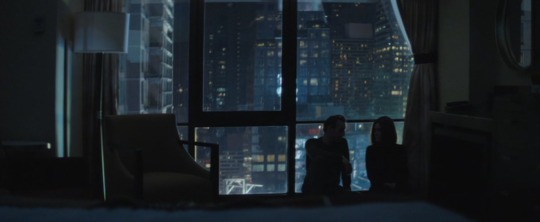
Félix et Meira (Maxime Giroux - 2014)
#Félix et Meira#Maxime Giroux#Canadian drama film#film#Canadian cinema#Canadian drama movie#Canadian movies#cinema#Quebec#movies#2010s cinema#2010s movies#Canadian society#2010s#Canada#Martin Dubreuil#Luzer Twersky#Hadas Yaron#Montreal#Jewish family#Hassidic Jewish#French Canadian people#loneliness#lovers#intimacy#Hassidic community
3 notes
·
View notes
Photo

Un nouvel article a été publié sur https://www.rollingstone.fr/le-deserteur-chronique/
"Le Déserteur" de Maxime Giroux, bel étranger

Les horreurs de la guerre ne s’arrêtent pas à l’instant où l’on décide de la fuir ! Ovni à la beauté sidérante, Le Déserteur est à voir absolument
“Nous sommes à une époque de grande tempête. Et toi, tu es au cul de la tempête…” Déserteur contraint d’errer à travers les immenses étendues mornes et désertiques avec son baluchon, ce chapeau melon et cette canne qui lui permettent à l’occasion de s’inscrire à des concours de sosies de Charlie Chaplin — et de les gagner —, Philippe (extraordinaire Martin Dubreuil) n’avait pas besoin de la confirmation orale de son tortionnaire à la tête d’un trafic d’êtres humains (Romain Duris assez succulent en salaud absolu) pour avoir un… éclairage assez précis de sa situation. Temps de guerre, temps de grande désolation, la frontière entre réel et irréel peut voler en éclats, le quotidien sans lendemain jongler entre horreur et fantastique et laisser submerger un monde parallèle plus angoissant et inhumain que celui auquel on tentait d’échapper. Film choc du mois.
youtube
No review found! Insert a valid review ID.
Xavier Bonnet
0 notes
Text
La Grande noirceur (Maxime Giroux, 2019)
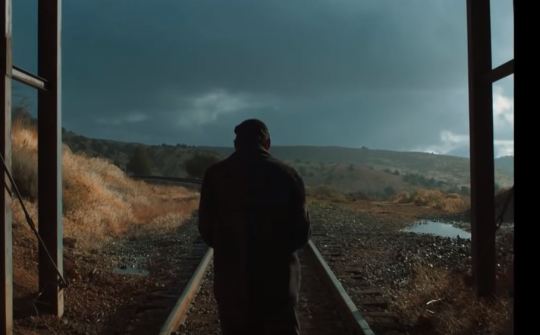
Une proposition de cinéma assez hors norme qu'est LA GRANDE NOIRCEUR de Maxime Giroux (Félix et Meira). Ce film pourrait aussi bien être le cauchemar de désertion d'un soldat que le rêve de servitude d'un canadien-français en sol américain. Le film ne donne pas beaucoup de pistes, et nous laisse à mi-chemin entre la fable onirique, la métaphore, et un espèce de naturalisme des images qui renforce l'expérience sensorielle. Du coup, on avance de façon très physique dans un monde quasi parallèle à celui des années 40 qu'on aurait grossi et déformé pour mieux en saisir l'absurdité. N'est-ce pas là la qualité des meilleurs rêves?
En tout cas, ce film fait tranquillement son effet. C'est le genre de rêve qui ne se volatilise pas instantanément au réveil. Il laisse un choc prégnant, et on y repense encore des jours après le visionnement. Il vieillira très bien selon moi.
Et Martin Dubreuil fait de la belle job d'équilibriste. Son rôle était difficile à jouer, et il assure dans un registre à des années lumières de son splendide rôle dans À Tous Ceux qui ne me lisent pas. C'est vraiment un grand acteur, et c'est un bonheur de le voir de plus en plus souvent dans le paysage cinéma.
0 notes
Text
Station Vu : À TOUS CEUX QUI NE ME LISENT PAS de Yan Giroux

On pouvait s’interroger sur la pertinence de tenter de transposer la poésie écrite au grand écran, mais ce portrait d’Yves Boisvert parvient admirablement à être plus cinématographique que littéraire. Yan Giroux, qui signe son premier long métrage, rend pratiquement chaque plan étonnant, inspirant, stimulant via ses compositions visuelles élaborées avec le directeur photo Ian Lagarde, incluant plusieurs amples mouvements d’appareil. Ce film sur les aléas de la vocation d’artiste dispose par ailleurs de l’arme de moins en moins secrète qu’est Martin Dubreuil, un de nos meilleurs acteurs, qui brille en artiste à la dérive, poussé par le vent, comme un chien errant, pauvre, mais bon vivant malgré tout.

À tous ceux qui ne me lisent pas est présenté chez Station Vu ce vendredi soir à 19 h 30 en présence de Yan Giroux et du co-scénariste Guillaume Corbeil. Le film sera présenté à nouveau le jeudi 17 janvier à 15 h. stationvu.com
0 notes
Text
SCHATTENKINO FÜR POSTMOTTEN
Alexander Wilson, Aesthesis and Perceptronium: On the Entanglement of Sensation, Cognition, and Matter, University of Minnesota Press
Anil Bhatti, Dorothee Kimmich, Albrecht Koschorke, Rudolf Schlögl, Jürgen Wertheimer, Ähnlichkeit, Internationales Archiv für Sozialgeschichte der deutschen Literatur
Arthur Kroker, Body Drift: Butler, Hayles, Haraway, University of Minnesota Press
Augusto Monterroso, Das Schwarze Schaf und andere Fabeln
Bernd Flessner, Nach dem Menschen: Der Mythos einer zweiten Schöpfung und das Entstehen einer posthumanen Kultur, Rombach
Bruce Clarke, Gaian Systems: Lynn Margulis, Neocybernetics, and the End of the Anthropocene, University of Minnesota Press
Bruce Clarke, Neocybernetics and Narrative, University of Minnesota Press
Carsten Strathausen, Bioaesthetics: Making Sense of Life in Science and the Arts, University of Minnesota Press
Cary Wolfe, What Is Posthumanism?, University of Minnesota Press
Catherine Bell, Performing Animality
Constance Classen, Worlds of Sense: Exploring the Senses in History and Across Cultures, Routledge
Cora Diamond, Fleisch essen und Menschen essen
Daniel S. Traber, Whiteness, Otherness and the Individualism Paradox From Huck to Punk, Palgrave Macmillan
David Cecchetto, Humanesis: Sound and Technological Posthumanism, University of Minnesota Press
David Farrier, Anthropocene Poetics: Deep Time, Sacrifice Zones, and Extinction, University of Minnesota Press
David Wills, Inanimation: Theories of Inorganic Life, University of Minnesota Press
David Wills, Dorsality: Thinking Back Through Technology and Politics, University of Minnesota Press
David Wood, Thinking Plant Animal Human: Encounters With Communities of Difference, University of Minnesota Press
Davide Tarizzo, Life: A Modern Invention, University of Minnesota Press
Debashish Banerji, Makarand R. Paranjape, Critical Posthumanism and Planetary Futures, Springer
Diana Walsh Pasulka, Michael Bess, Posthumanism: An Introductory Handbook, Macmillan
Dominic Pettman, Creaturely Love: How Desire Makes Us More and Less Than Human, University of Minnesota Press
Dominic Pettman, Human Error: Species-Being and Media Machines, University of Minnesota Press
Donna J. Haraway, Die Neuerfindung der Natur: Primaten, Cyborgs und Frauen, Campus-Verlag
Donna J. Haraway, When Species Meet, University of Minnesota Press
Donna J. Haraway, Cary Wolfe, Manifestly Haraway, University of Minnesota Press
Drew Ayers, Spectacular Posthumanism: The Digital Vernacular of Visual Effects, Bloomsbury Academic
Edwina Ashton, Steve Baker, The Salon of Becoming-Animal, New York University and the Massachusetts Institute of Technology
Élisabeth Fontenay, Without Offending Humans, University of Minnesota Press
Elizabeth Grosz, Animal Sex: Libido as Desire and Death, Routledge
Erik Hannerz, Performing Punk, Palgrave Macmillan
Erika Cudworth, Stephen Hobden, The Emancipatory Project of Posthumanism, Routledge
Ernst Kapp, Elements of a Philosophy of Technology: On the Evolutionary History of Culture, University of Minnesota Press
Francesca Ferrando, Philosophical Posthumanism, Bloomsbury Publishing
Gilbert Simondon, Individuation in Light of Notions of Form and Information, University of Minnesota Press
Gilles Deleuze, Felix Guattari, Tausend Plateaus. Kapitalismus und Schizophrenie, Merve Verlag
Giovnni Aloi, Deleuzian
Glemens-Garl Härle, Karten zu Tausend Plateaus, Merve Verlag
Ian Bogost, Alien Phenomenology, Or, What It's Like to Be a Thing, University of Minnesota Press
Ilya Prigogine, Isabelle Stengers, Order Out of Chaos: Man's New Dialogue With Nature, Bantam New Age Books
Indra Sinha, Menschentier, Edition Büchergilde
Isabelle Stengers, Thinking With Whitehead a Free and Wild Creation of Concepts, Harvard University Press
Isabelle Stengers, Cosmopolitics I, University of Minnesota Press
Isabelle Stengers, Cosmopolitics II, University of Minnesota Press
Jacques Derrida, Ned Lukacher, Cinders, University of Minnesota Press
Jakob von Uexküll, A Foray Into the Worlds of Animals and Humans: With a Theory of Meaning, University of Minnesota Press
Jamie Lorimer, The Probiotic Planet: Using Life to Manage Life, University of Minnesota Press
Joey Keithley, Jack Rabid, I, Shithead: A Life in Punk, Arsenal Pulp Press
John Ó Maoilearca, All Thoughts Are Equal: Laruelle and Nonhuman Philosophy, University of Minnesota Press
John Protevi, Political Affect, University of Minnesota Press
John Robb, Punk Rock: An Oral History, PM Press
Judith Roof, The Poetics of DNA, University of Minnesota Press
Julian Yates, Of Sheep, Oranges, and Yeast: A Multispecies Impression, University of Minnesota Press
Julius Zimmermann, Die Eigenständigkeit der Dinge
Jussi Parikka, Insect Media: An Archaeology of Animals and Technology, University of Minnesota Press
Kalpana Rahita Seshadri, HumAnimal: Race, Law, Language, University of Minnesota Press
Karen Pinkus, Fuel: A Speculative Dictionary, University of Minnesota Press
Kate Devlin, Turned On: Science, Sex and Robots, Bloomsbury Sigma
Kathy High, I offer my power in the service of love
Laura Erickson-Schroth, Trans Bodies, Trans Selves: A Resource for the Transgender Community, Oxford University Press
Laurent Dubreuil, The Intellective Space: Thinking Beyond Cognition, University of Minnesota Press
Laurent Dubreuil, Sue Savage-Rumbaugh, Dialogues on the Human Ape, University of Minnesota Press
Legs McNeil & Gillian McCain, Please Kill Me: The Uncensored Oral History of Punk, Grove/Atlantic, Inc.
Lutz Dammbeck, DAS NETZ - Die Konstruktion des Unabombers & Das "Unabomber-Manifest": Die Industrielle Gesellschaft und ihre Zukunft: Nautlius Flugschrift, Edition Nautilus
Mads Rosendahl Thomsen, The Bloomsbury Handbook of Posthumanism, Bloomsbury Academic
Marcel O'Gorman, Necromedia, University of Minnesota Press
María Puig de La Bellacasa, Matters of Care: Speculative Ethics in More Than Human Worlds, University of Minnesota Press
Martin Kurthen, Robert Payne, White and Black Posthumanism: After Consciousness and the Unconscious, Springer
Matthew Fuller, Olga Goriunova, Bleak Joys: Aesthetics of Ecology and Impossibility, University of Minnesota Press
Michael Hauskeller, Curtis D. Carbonell, Thomas D. Philbeck, The Palgrave Handbook of Posthumanism in Film and Television, Palgrave Macmillan
Michael Haworth, Neurotechnology and the End of Finitude, University of Minnesota Press
Michel Serres, The Parasite, University of Minnesota Press
Mick Smith, Against Ecological Sovereignty, University of Minnesota Press
Mickey Weems, The Fierce Tribe: Masculine Identity and Performance in the Circuit, University press of Colorado
Neil H. Kessler, Ontology and Closeness in Human-Nature Relationships: Beyond Dualisms, Materialism and Posthumanism, Springer
ngbk, Tier-werden, Mensch-werden
Nicole Shukin, Animal Capital: Rendering Life in Biopolitical Times, University of Minnesota Press
Nigel Rothfels, Representing Animals, Indiana University Press
Oliver Krüger, Die Vervollkommnung des Menschen, E-Pub
Peter Atterton & Matthew Calarco, Animal Philosophy, Ethics and Identity: Essential Readings in Continental Thought, Continuum
Peter Mahon, Posthumanism: A Guide for the Perplexed, Bloomsbury Academic
Phillip Thurtle, Biology in the Grid: Graphic Design and the Envisioning of Life, University of Minnesota Press
Raymond Ruyer, Neofinalism, University of Minnesota Press
Riccardo Campa, Humans and Automata: A Social Study of Robotics, Peter Lang
Roberto Esposito, Bios: Biopolitics and Philosophy, University of Minnesota Press
Roger F. Cook, Postcinematic Vision: The Coevolution of Moving-Image Media and the Spectator, University of Minnesota Press
Ron Broglio, Surface Encounters: Thinking With Animals and Art, University of Minnesota Press
Siegfried Zielinski, Variations on Media Thinking, University of Minnesota Press
Stanislaw Lem, Sterntagebücher
Stefan Lorenz Sorgner, Branka-Rista Jovanovic, Evolution and the Future: Anthropology, Ethics, Religion- in Cooperation With Nikola Grimm, Peter Lang
Steve Baker, Artist Animal, University of Minnesota Press
Steven Shaviro, The Universe of Things: On Speculative Realism, University of Minnesota Press
Susan McHugh, Animal Stories: Narrating Across Species Lines, University of Minnesota Press
Thierry Bardini, Junkware, University of Minnesota Press
Timothy C. Campbell, Improper Life: Technology and Biopolitics From Heidegger to Agamben, University of Minnesota Press
Timothy Campbell, Adam Sitze, Biopolitics: A Reader, Duke University Press
Timothy Morton, Hyperobjects: Philosophy and Ecology After the End of the World, University of Minnesota Press
Tom Tyler, CIFERAE: A Bestiary in Five Fingers, University of Minnesota Press
Vilém Flusser, Rodrigo Maltez Novaes, Vampyroteuthis Infernalis, Atropos Press
Vinciane Despret, What Would Animals Say if We Asked the Right Questions?, University of Minnesota Press
6 notes
·
View notes
Photo

Source : Dubreuil, Émilie, «“Nous allons former des analphabètes culturels”», site de Radio-Canada, 13 décembre 2020.
Au début du vingt-troisième chapitre de Candide, «Candide et Martin vont sur les côtes d’Angleterre; ce qu’ils y voient», Candide discute avec Martin sur le pont d’un navire hollandais : «Vous connaissez l’Angleterre; y est-on aussi fou qu’en France ? — C’est une autre espèce de folie, dit Martin. Vous savez que ces deux nations sont en guerre pour quelques arpents de neige vers le Canada, et qu’elles dépensent pour cette belle guerre beaucoup plus que tout le Canada ne vaut.»
0 notes
Text
Who’s Who in Louisiana Supernatural Society
The Loa
Baron Samedi
Papa Legba
Magic Users
Voodoo Practitioners
Anaïca Catoire
Laurent Catoire
Sabine Catoire
Ruby Villars-Dubreuil
Kali Oubre
Witches
Presley Lemoine (Coven Head)
Annalyse Lemoine (deceased)
Evangeline Lemoine
Sasha Wytcoff (NPC - transplant from Philly)
Marie Jeanette LeClaire (Coven Head)
Lydiane Richard
Hadley Martin
Sofia Delaune
Raelynne Surette
Vampires
Laine Brooks
Lillian Finley
Werewolves
The New Orleans Pack
Elisse Theriot
Veronica Ardouin
The Terrebonne Pack
Andre Romero (Alpha)
Renee Romero
Gentry Pincer
Montgomery Pincer
Landry Pincer (Andre’s Second in Command)
Mason Pincer
Cecile Pincer
Aurore Guidry
Auguste “Gus” Fontenot
Breanne “Bre” Danvers (NPC)
Emmeline “Em” Bordelon (NPC)
Jack Fontenot (son of Gud Fontenot)
Bastian “Bas” Romero (son of Andre and Eva)
Artemis “Emi” Romero (daughter of Andre and Eva)
Josette “Jo” Pincer (daughter of Landry and Aurore)
Other
Felix Miller (member of the Spirit Chasers)
Aidan Silva (NPC; member of the Spirit Chasers)
Richard Carter (Network Liaison)
Cooper Montgomery
Charlotte Montgomery
Parker and Sarabeth Montgomery (NPCs)
Madison Holmes (works for Holmes Realty)
Danny Holmes (works for Holmes Realty)
Adrienne Philips (works for Holmes Realty)
0 notes
Photo

Décor-Export / Pascal Osten
https://www.facebook.com/groups/1938237242977933/
Et merci aussi aux 320 contributeurs, on s'est tellement marrés, :-) / Thank you to the 320 contributors , we laugh so so much guys! DÉCOR EXPORT - Eric Tabuchi & Nelly Monnier
>https://bit.ly/2XuCVcm
Martine Aballéa, Guillaume Abgrall, Steve Abraham, Marc Adi, Juli Aïko, Guillaume Alarm, Pascal Anders, Philip Anstett, Pepe Anta, Emmanuel Aragon, Sébastien Arrighi, Guillaume Aubry, Chloé Azzopardi, Héloise Bariol, Alex Barrow, Kasper Barrow Tabuchi, Antoine Barth, Grégoire Bassinet, Nicolas Baudouin, Caroline Bauer, Lionel Bayol-Thémines, Pierre Belouin, Laura Ben Haïba, Yoann Bergouts, Mai-Li Bernard, Manuel Bienven, Bernadette Blasco, Luc Boegly, Philippe Boisnard, Jacques Bon, Sandrine Bonami-Redler, Jean Bonichon, Guillaume Bonnal, Karine Bonneval, Cécile Bouffard, Capucine Boureau, Christophe Bouvier, Anne-Laure Boyer, Bonnie Broc, Stéphane Bruchet, Magali Brueder, Alain Buhot, Hervé Cabine, Corinne Caule, Martine Chiarappa, Philippe Caillaud, Cédric Canaud, Martin Cares, Johanna Cartier, Fabrice Cazenave, Garance Chabert, Oriane Charvieux, Mylène Chevalier Despicht, Julie ChOvin, Thierry Chantegret, Marion Chopin, Carole Cicciu, Gaëlle Cognée, Marianne Colombani, Daphné Comte Lefebvre, Alexandre Contesse, Bastien Contraire, Leïla Couradin, Gilles Courtinat, Daniel Clauzier, Arthur Crestani, Karin Crona, Béatrice de Crécy, Alexandra Czmil, Simon de la Porte, Béatrice Darnal, Claire Daudin, Corinne et Max Delort, Gaëlle Delort, Paul D’Haese, Fabien Dendiével, Stéphanie Deneux, Joséphine Derbru, Simon Desloges, Olivier Despicht, Hugo Deverchère, Julie Digard, Nicolas Dubreuil, Rémi Dubroca, Maxime Dufour, Myriam Dugast, Matthieu Duperrex, Philippe Durand Editions de l’Obsession + Mathilde Luguet, Cédric Esturillo, François-Noé Fabre, Marie Farge, Quentin Faucompré, Sébastien Fayard, Marianne Ferrand, Edwige Fontaine, Bruno Fontana, Morgane Forsberg, Alain François, Fred, Romain Gamba, Jill Gasparina, Hortense Gauthier, Franck Gérard, Hughes Germain, Thierry Girard, Nicolas Godin, Emmanuel Gonzalez, Julien Gorgeart, Françoise Goria, Pauline Gouablin, Jeremy Gouellou, Fabien Granet, Jérôme Gras, Simon Grass, Dan Gregory, Fabrice Grelat-Mabime, Céline Guichard, Charlène Guillaume, Jill Guillais, Victoria Guinet, Maïwenn Hamon, Sophie Hasslauer, Vincent Herlemont, Peter Hill, Hippolyte Hentgen, Olivier Hodasava, Taeyang Hong, Chourouk Hriech, Anabelle Hulaut , Olivier Huz, Audrey Jamme, François Jenssard, Nathalie Jover, Xavier Julien, Jean Pierre Junqua, Alexandre Jutard-Verdon, Katia Kameli, Thomas Karges, Frédéric Khodja, Dorine Knecht, Perrine Lacroix, Angèle Là-Dessus, Damien Lajeunesse, Cendrine Lassale, Stéphane Laurent, Pierre Lazare, Pierre lazare, Olivier Leclercq, P.-Nicolas Ledoux, Dominique Le Duff, Paulin Lefeuvre, Laurence Lefèvre, Loïc Le Gall, Mériol Lehmann, Julien Lelièvre, Philippe Lenepveu, Stéphane Leroy, Corentin Lespagnol, Laure Letinois, Hélène Letteron, Valery Levacher, Loïc Le Verche, Julien Lévy, Sophie Liados, François Lichté, Paul Lisse Partout, Julien Lombardi, Alexandre Longeot, Jiali Lou, Fred Maillard, Fabrice Maintoux, Denis Malbos, Gilles Malatray, Marion Mallet, Gabrielle Manglou, Evelyne Marchive, Martial Marquet, Eve Martin, Léna Martinez, Roberto Martinez, Mariette Marty, Geoffroy Mathieu, Lucia Mazzucato, Matière Production, Fanette Mellier, Catherine Merdy, Thierry Merré, Vanessa Messalti, Cécile Meynier, Eric Michel, Nicolas Milhé, Tanguy Miniclash, Jean Moal, Cyrielle Monnier, Nelly Monnier, Théo Monnier, Margaux Montigny, Sandra Moreaux, Armand Morin, Juliette Morel, Xavier Morlet, Sophie Mouron, Alice Mulliez, Philippe Munda, Nicolas Nadé, Olivier Namias, Boris Nauleau, Julien Nédélec, Macula Nigra, Vincent Nirvalet, Laurie Noyelle, Sian O’Keeffe, Baldo Ortas-Peretti, Pascal Osten, Clément Paradis, Hervé Paraponaris, Didier Paris, Hélène Paris, Julien Pasteau, Ariadna Pastorini, Anne-Marie Pernot, Antony Pesrin, Véronique Pérus, Mathias Pfund, Emmanuelle Pidoux, Virginie Piotrowski, Nicolas Pincemin, Juliette Plisson, Rémi Pollio, David Posth-Kohler, Eric Pringels, Bostjan Pucelj, Clara Pugliese, Mickaël Puiravau, Judith Quentel, Florent Quignon, Annakarin Quinto, Simon Rayssac, Manon Recordon, Tony Regazzoni, Marguerite Reinert, Mathieu Renard, Serge Renaudie, Marie-Hélène Richard, Ben Riollet, David Ritzinger, Yann Rondeau, Laetitia Rouiller, Patrick Roussel, Alex Roux, Linda Roux, Olivier Ruffinetto-Delhaise, Alex Rx, Mickaël Salvi, Patrice Santa Coloma, Benoit Santiard, Thomas Sauvin, Julie Savoye, Nils Savoye, Alice Sawicki, Mike Saxenhammer, Bruno Scotti, Olivier Seignette , Michaël Sellam, Vadim Sérandon, Rémy Sergent, Mathieu Siméon, Sylvain Simon, Jerome Sother, Olivier Soulié, Sophie Soum, Charline Sowa, Dominique Spiessert, Sammy Stein, Vincent J. Stoker, Karin Szabo-Detchart, Eric Tabuchi, Jean-Jacques Tardif, Cédric Teisseire, Denis Thomas, Bénédicte Thoraval, Julien Tiberi, Nicolas Tourre, Nicolas Tourte, Giulia Turati, Jack Usine, Euqinimod Uthagey, Julie Vacher, Olivier Vadrot, Yannick Vallet, Claire Van Der Meulen, César Vayssié, Erwan Venn, Bénédicte Vidal, Colas Vienne, Aurélien Villette, Héléna Villovitch+ Anne Laplantine, Laure Waast, Adrianna Wallis, Hazel Ann Watling Xtr, Patricia Welinski, Marion Wintrebert, Zed Zardoz, Yves Zbinden, Amata Zdiziobeck, Philippe Zulaica
1 note
·
View note
Text
De 10 Foto's Met Een Lang Verhaal Staan in een blog, op Tumblr. 100
De Straatweg vanaf de kruising met de Kleiweg (links) en de Kootsekade (rechts), 1935.
De Straatweg loopt van de Ceintuurbaan tot aan de splitsing Bergse Dorpsstraat en Weissenbruchlaan en tussen de Bergse Voorplas en de Bergse Achterplas door. De vroegere naam was Bergweg.
De Kleiweg werd vroeger wel beschouwd als een onderdeel van een oude zeedijk, die door de Romeinen zou zijn aangelegd. De vroegst bekende dijk dateert echter van de 12de eeuw en bevindt zich bovendien ten zuiden van de Kleiweg. Deze dankt haar naam aan de Kleiweg in het veen (oeverwal van een stroom) waarop zij is gelegen. De naam 'Cleyweg' komt voor zover bekend voor het eerst in 1419 voor. De wijk Kleiwegkwartier wordt thans ook aangeduid met Hillegersberg Zuid.
Deze kade is vernoemd naar oliemolen 'de Koot' aan de Rotte op de hoek van de Rechter Rottekade en de Kootsekade, eertijds toebehorend aan de firma H. Lambert en Zonen. Hier werd lijn- en raapzaad geperst. De molen werd in 1905 afgebroken en in Vaals (Limburg) weer opgebouwd (later in 1934 afgebrand). Op de kaart van A. Dubreuil uit 1784 komt de molen reeds voor. Hij is hierop echter nog niet met name genoemd. In 1776 werd hij als pelmolen gebouwd en omstreeks 1850 omgebouwd tot oliemolen. Op de kaart van Schieland van Floris Balthazar (1611) komt de kade onder de naam Rijskae voor. Waarschijnlijk was deze kade oorspronkelijk gedekt met rijsbeslag.
De prentbriefkaart komt uit het Stadsarchief Rotterdam. De informatie komt eveneens uit het Stadsarchief Rotterdam.
Bron, Rotterdam van Toen, Stads Archief Rotterdam

De Oude Binnenweg met verderop het Schielandshuis, 1972-1978.
Sinds 1977 heet het gedeelte van de Binnenweg tussen Karel Doormanstraat en Westersingel Oude Binnenweg. Al in 1454 liep door de Coolpolder een binnenweg van Rotterdam naar Schoonderloo met een afslag naar Delfshaven. Deze heette Coolsche weg of Binnenweg; het laatste gedeelte komt voor als Schoonderloosche of Delfshavensche weg of Binnenweg, maar heet na 1610 gewoonlijk Geldelooze pad. Hier vandaan liep een uitpad over een vonder of passerel naar de Ossewei en daarover naar het Lage Erf.
De bebouwing aan de Binnenweg bij Rotterdam had in de 17de eeuw de tegenwoordige Mauritsstraat bereikt; in 1706 werd dit gedeelte bestraat en met bomen beplant. Pas het graven van de Westersingel bracht hierin verandering. Ten westen daarvan op Delfshavens grondgebied kwamen toen ook straten en sinds 1852 bestonden er plannen om de Binnenweg te verbeteren en een betere verkeersweg te maken tussen Rotterdam en Delfshaven. In 1876 werd daarmee begonnen.
De oude Binnenweg bleef tot de Josephstraat bestaan, doch vandaar is zuidelijk van de bestaande Binnenweg een nieuwe verkeersweg gemaakt tot het hierboven genoemde uitpad. Dit pad werd verbeterd en verbreed tot Delfshaven. In 1888 is voor het gedeelte van de Coolsingel tot Westersingel de bijvoeging 'oude' verdwenen, het gedeelte van de Westersingel tot Josephstraat is, hoewel oud, gerekend te behoren tot de Nieuwe Binnenweg. Het oude gedeelte, dat van de Josephstraat de polder inliep langs de tegenwoordige Schietbaanstraat, tot waar het met een hoek op de tegenwoordige Schonebergerweg uitkwam, bleef Oude Binnenweg en van die hoek tot het kerkhof te Schoonderloo, Geldelooze pad of Zwarte wegje.
In 1977 is de bijvoeging 'oude' weer in ere hersteld voor het gedeelte van de Binnenweg tussen Karel Doormanstraat en Westersingel. Het gedeelte van de weg tussen Coolsingel en Karel Doormanstraat heet sinds 1971 Binnenwegplein.
De fotograaf is Lex de Herder en de foto komt uit het Stadsarchief Rotterdam. De informatie komt eveneens uit het Stadsarchief Rotterdam.
Bron, Rotterdam van Toen, Stads Archief Rotterdam

We kijken naar het Erasmiaans Gymnasium aan de Coolvest, de latere Coolsingel, in 1897. Het gebouw aan de linker kant is dan net 13 jaar in gebruik en zal dienst doen tot 1937. Het gebouw werd op 14 mei 1940 gebombardeerd. Op deze plek herrees later de winkel van C&A.
De gymnasiasten en hun docenten waren voor de oorlog dus al verhuisd naar de Wytemaweg. Daar huist de school nog steeds. Het gebouw werd na het bombardement gebruikt voor de distributie van hulpgoederen.
De oorlog liet diepe sporen na in de school. Eenderde van de leerlingen kwam om het leven. Sommigen overleden in de stad zelf, anderen werden naar kampen gestuurd. Elk jaar worden de namen van de 101 leerlingen die het leven lieten voorgelezen in de aula van de school.
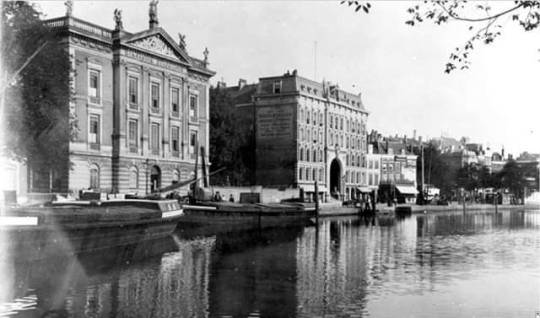
Gezicht op de Grondherendijk bij de Rietdijk, 1934.
De Grondherendijk Is vernoemd naar de grondheren (grondeigenaars) van Charlois. Vóór 1895 droeg de Grondherendijk de naam Hooge Dijk. De Grondherenstraat ligt op het terrein van de vroegere Kerkegrient.
Een verklaring van de naam Rietdijk wordt gezocht in een belofte van Jan van Almonde en Joris de Bije om de Riethille, ten noorden van de Robbenoordse polder te bekaden. Zij hadden in 1525 Robbenoord en deze Riethille in pacht. Een reeds in 1482 genoemd stuk land, 'dat rietblok', zal ook wel in deze buurt gezocht moeten worden.
Charlois (spreek uit: sjaarloos) en de Riederwaard (Reijerwaard) behoorden vroeger tot het land van Putten, een geheel onafhankelijk gebied met een eigen regering en een eigen recht. In 1456 ging dit gebied over van de heren van Gaesbeek op de hertog van Bourgondië, die er zijn zoon Karel de Stoute, graaf van Charollois (een graafschap in Bourgondië), mee beleende. Door de vele hoge vloeden in de 14de en 15de eeuw liep dit gebied regelmatig onder water. Karel de Stoute wilde in 1460 'die lande, slijck, uterwairt ende Rietbroek, geheiten Riderwairt' laten bedijken. Als voorwaarden werden daarbij gesteld dat dit land niet meer Riederwaard, doch Charlois zou heten, en dat er een kerk gesticht zou worden, gewijd aan Sint Clemens. Dit land omvatte de latere polders Karnemelksland, de Hille, Charlois, Robbenoord en Plompert. Door de goede bedijking en de gunstige ligging werd het gebied spoedig bebouwd. Charlois was zowel een ambachtsheerlijkheid als een grondheerlijkheid. Bij eerstgenoemde berustte de jurisdictie, terwijl aan het bestuur van laatstgenoemde de zorg voor waterstaatszaken was opgedragen. In 1895 is Charlois door Rotterdam geannexeerd.
De prentbriefkaart komt uit het Stadsarchief Rotterdam. De informatie komt eveneens uit het Stadsarchief Rotterdam.
Bron, Rotterdam van Toen, Stads Archief Rotterdam

Gezicht op de Bergweg (uit het zuiden) richting het spoorwegviaduct van de Ceintuurbaan bij station Hillegersberg, 1920 (geschat).
Station Rotterdam Noord is een station in de Rotterdamse deelgemeente Noord, gelegen aan de spoorlijn Rotterdam Centraal – Gouda. Het ligt aan de vroegere Ceintuurbaan op dezelfde plaats als de vroegere halte Hillegersberg, die in 1899 geopend werd.
Met de verlegging van het treinverkeer uit de richting Gouda van station Rotterdam Maas naar het Centraal Station via deze route, werd station Rotterdam Noord op 4 oktober 1953 geopend. Het ligt na een spoorviaduct over de Bergweg die vlak daarna in de Straatweg overgaat, de verbindingsweg van de stad met Hillegersberg; het viaduct is het bovenstuk van het zogeheten Muizengaatje.
Het station is van architect Sybold van Ravesteyn, die het station in de stijl van de Nieuwe zakelijkheid heeft ontworpen. Het stationsgebouw is niet meer als zodanig in gebruik.
De Bergweg dankt zijn naam aan het voormalige dorp Hillegersberg, ook wel Den Berg genoemd, dat in 1941 door Rotterdam werd geannexeerd. De Bergweg heette vóór 1897 Oost-Blommersdijkschenweg. De Bergweg maakte deel uit van de oude 12de eeuwse zeedijk. De naam 'Berchwech' komt in 1387 voor het eerst voor. In de 19de eeuw treft men ook de naam Blommersdijksche Straatweg aan.
De prentbriefkaart komt uit het Stadsarchief Rotterdam. De informatie komt van Wikipedia en uit het Stadsarchief Rotterdam.
Bron, Rotterdam van Toen, Stads Archief Rotterdam
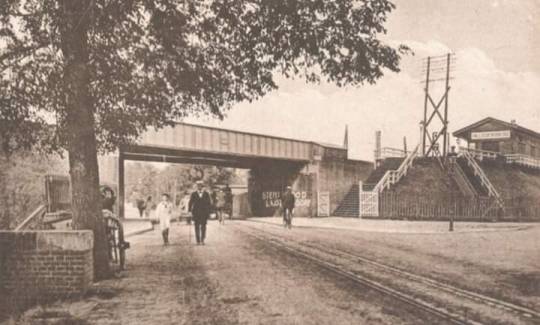
Gezicht op de ingang van de Rotterdamse Diergaarde aan de Kruisstraat, 1899.
Rond 1855 richtten twee spoorwegbeambten een spoortuintje in de Rotterdamse binnenstad in om hun verzameling exotische vogels onder te brengen. Deze hobby-vogeltuin werd een groot succes en leidde tot de oprichting van de 'De Rotterdamsche Diergaarde' in 1857. De eerste directeur was Henri Martin, oorspronkelijk leeuwentemmer van beroep. Aanvankelijk mochten alleen leden van de vereniging de dierentuin bezoeken.
In 1857 kreeg J.D. Zocher van de gemeente de opdracht om de tuin voor de Diergaarde aan te leggen. De bedoeling was om op een aangename wijze kennis van dieren en planten te bevorderen. Zocher voerde het plan uit samen met zijn zoon Louis Paul. De Diergaarde was een enorm succes. Tijdens de aanleg kon men de dieren al bezichtigen en binnen acht maanden tijd leverde dat ruim twaalfduizend bezoekers op. Daaronder bevonden zich bijna vierduizend stadgenoten die geen lid waren. Het lidmaatschap was namelijk erg duur, maar eenmaal per jaar, tijdens de kermis, kon de gewone man voor een gereduceerd tarief de dierentuin bezoeken.
De ingang van de Diergaarde was aan de Kruiskade. Rondom het terrein was een fraai hek geplaatst. De dierenverblijven en andere gebouwen werden ontworpen door de architecten A.W. van Dam en H.J. de Haas. In 1862 werd de Diergaarde uitgebreid, waarbij opnieuw de hulp van Zocher werd ingeroepen. Dit gedeelte, dat bekend werd onder de naam Nieuwe Tuin, sloot naadloos aan bij het oude gedeelte. De Diergaarde kon zich meten met die van Amsterdam en Antwerpen dankzij de smaakvolle aanleg van Zocher.
In 1937 besloot het gemeentebestuur van Rotterdam dat de Diergaarde uit het stadscentrum moest wijken voor stedelijke bebouwing. Vanwege het steeds drukker wordende verkeer werd de Diergaarde verplaatst naar de wijk Blijdorp. Het jaar erop begon men met de bouw van de nieuwe Diergaarde 'Blijdorp', genoemd naar de polder Blijdorp, waar de tuin nog steeds gehuisvest is. Architect S. Van Ravesteyn kreeg de opdracht voor het ontwerp.
De fotograaf is Carl Emile Mögle en de foto komt uit het Stadsarchief Rotterdam. De informatie komt eveneens uit het Stadsarchief Rotterdam. De kaart uit 1897 komt van rotterdamkaart.nl
Bron, Rotterdam van Toen, Stads Archief Rotterdam

Het Hofplein bij het spoorwegviaduct met op de achtergrond de Blaauwe Molen, 6 oktober 1928.
Het Hofplein herinnert aan de ridderhofstad Weena, die noordoostelijk van het huidige Hofplein was gelegen. De Hofdijk komt al in 1397 in bronnen voor. Het slot wordt reeds in 1306 vermeld. De oorspronkelijke Hofdijk stamde uit de 13de eeuw en strekte zich langs de Rotte uit tot het Zwaanshals en de Oudedijk. Het Hofplein ontstond in de eerste helft van de 19de eeuw nadat de Kolk of Gracht tussen de Delftse Poort en de Hofpoort was gedempt. Van 1853 tot 1875 was het plein als veemarkt ingericht. De oudste naam is Hofpoortplein naar de Hofpoort die daar stond en in 1833 is afgebroken. In 1908 werd aan het plein het station van de Zuid-Hollandsche Electrische Spoorweg-Maatschappij, de lijn Rotterdam-Scheveningen, geopend. Bij besluit B&W 13 september 1949 ontving het verkeersplein op het kruispunt Coolsingel, Weena, Schiekade, Pompenburg de naam Hofplein.
De foto is gemaakt door de Fototechnische Dienst Rotterdam en komt uit het Stadsarchief Rotterdam. De informatie komt eveneens uit het Stadsarchief Rotterdam.
Bron, Rotterdam van Toen, Stads Archief Rotterdam

De Nieuwe Binnenweg bij de Heemraadssingel met op de hoek café 't Spinnewiel, februari 1929. Café 't Spinnewiel is net van eigenaar veranderd en heet nu Bakeliet.
De Heemraadssingel is vernoemd naar de heemraden van Schieland. Deze naam herinnert aan de poldergeschiedenis. Vóór de aanleg van de singel liep hier de Heemraadsweg, welke naam bij besluit B&W 27 juli 1894 was vastgesteld.
Al in 1454 liep door de Coolpolder een binnenweg van Rotterdam naar Schoonderloo met een afslag naar Delfshaven. Deze heette Coolsche weg of Binnenweg; het laatste gedeelte komt voor als Schoonderloosche of Delfshavensche weg of Binnenweg, maar heet na 1610 gewoonlijk Geldelooze pad. Hier vandaan liep een uitpad over een vonder of passerel naar de Ossewei en daarover naar het Lage Erf. De bebouwing aan de Binnenweg bij Rotterdam had in de 17de eeuw de tegenwoordige Mauritsstraat bereikt; in 1706 werd dit gedeelte bestraat en met bomen beplant. Pas het graven van de Westersingel bracht hierin verandering. Ten westen daarvan op Delfshavens grondgebied kwamen toen ook straten en sinds 1852 bestonden er plannen om de Binnenweg te verbeteren en een betere verkeersweg te maken tussen Rotterdam en Delfshaven. In 1876 werd daarmee begonnen. De oude Binnenweg bleef tot de Josephstraat bestaan, doch vandaar is zuidelijk van de bestaande Binnenweg een nieuwe verkeersweg gemaakt tot het hierboven genoemde uitpad. Dit pad werd verbeterd en verbreed tot Delfshaven.
In 1888 is voor het gedeelte van de Coolsingel tot Westersingel de bijvoeging 'oude' verdwenen, het gedeelte van de Westersingel tot Josephstraat is, hoewel oud, gerekend te behoren tot de Nieuwe Binnenweg. Het oude gedeelte, dat van de Josephstraat de polder inliep langs de tegenwoordige Schietbaanstraat, tot waar het met een hoek op de tegenwoordige Schonebergerweg uitkwam, bleef Oude Binnenweg en van die hoek tot het kerkhof te Schoonderloo, Geldelooze pad of Zwarte wegje.
De foto is gemaakt door de Gemeentepolitie Rotterdam en komt uit het Stadsarchief Rotterdam. De informatie komt eveneens uit het Stadsarchief Rotterdam.
Bron, Rotterdam van Toen, Stads Archief Rotterdam

Tramongeluk op de hoek van de Goudsesingel en de Jonker Fransstraat, 1928-1932.
De Goudse Rijweg, Goudseweg en (vooroorlogse) Goudsewagenstraat vormden een onderdeel van de oude weg naar Gouda. De Goudsewagenstraat wordt reeds in 1366 in bronnen vermeld. Na 1358, toen er grachten om de stad gemaakt mochten worden, zal ook bij deze 'rijweg' aan de stadsvest een poort gebouwd zijn en kon men van Gouda daardoor met wagens in de stad, d.w.z. op de Hoogstraat, komen. Later was hier het beginpunt van het Goudse Wagenveer.
De Goudsesingel was oorspronkelijk de buiten de stad gelegen vestkade. In 1481 wordt de singel genoemd van de Oostpoort naar het kleine Goudse Poortje. Deze singel moet even ten noorden van de huidige Warande en het Ammanplein hebben gelegen. Na 1505, toen de stad in zuidelijke richting was ingekrompen, verstaat men onder Goudsesingel de weg van de Goudse Poort tot Couwenburghseiland (ter hoogte van het huidige Pompenburg). Ten oosten van de Goudse Poort heette hij Oostsingel. De Goudsesingel en Oostsingel waren de kaden ten noorden van de Goudsevest en de Oostvest. Het eerste gedeelte van de Oostvest werd in 1871 gedempt. Dit gedeelte heette sindsdien Gedempte Oostvest. In 1888 volgde de demping van het tweede gedeelte. Op deze plaats ontstond het Oostvestplein. Ook de Goudsevest en Luthersche Vest werden gedempt. Nadat de demping was voltooid, ontving de nieuw gevormde brede weg vanaf het Boschje tot aan het Oostplein de naam Goudsesingel. Opnieuw benoemd op 30 juni 1942.
Frans van Brederode bijgenaamd Jonker Frans of Roofridder Frans (Kasteel Batenstein te Vianen, 4 februari 1465 - Dordrecht, 11 augustus 1490) was een hoofdrolspeler in de naar hem vernoemde Jonker Fransenoorlog tijdens de Hoekse en Kabeljauwse twisten.
De foto is gemaakt door de Gemeentepolitie Rotterdam en komt uit het Stadsarchief Rotterdam. De informatie komt eveneens uit het Stadsarchief Rotterdam en van Wikipedia.
Bron, Rotterdam van Toen, Stads Archief Rotterdam

Op de Lijnbaan staat een van de Efteling geleende Holle Bolle Gijs in het kader van de schoonmaakactie Rotterdam Schoon Schip. Burgemeestersvrouw Thomassen-Lind, voorzitster van 't werkcomité Rotterdam Schoon Schip, staat voor Holle Bolle Gijs.
Buik liefst bol...
(Van een onzer verslaggevers) „Papier hier, dank u wel," klinkt het over de Lijnbaan, als kinderen stukjes papier en ander afval in de mond van Holle Bolle Gijs stoppen. Gistermiddag had mevrouw Thomassen-Lind, voorzitster van 't werkcomité Rotterdam Schoon Schip, gezorgd voor de snoepjes. De kinderen zorgden er daarna wel voor dat Holle Bolle Gijs kon blijven praten.
Daarvoor had mevrouw Thomassen deze straatactie ingeluid. Het doel van de actie is de straatverontreiniging tegen te gaan, door de mensen er toe te brengen het afval op de daarvóór bestemde plaatsen te deponeren. Zo zullen gedurende deze Schoon Schip-actie op woensdag- en zaterdagmiddagen verkeersbrigadiertjes als:Schoonschippers automobilisten op de parkeerplaatsen in de omgeving vragen hun asbakjes te mogen legen, en hun een raamsticker van Schoon Schip aan te bieden.
Op de Lijnbaan knopen vrijwillige medewerksters met. belangstellende voorbijgangers een gesprekje aan om op het grote belang van het voorkomen van straatverontreiniging te wijzen. De actie zal veertien dagen duren.
De fotograaf is Ary Groeneveld en de foto komt uit het Stadsarchief Rotterdam. De informatie komt via delpher.nl uit het Vrije Volk van 7 maart 1969.
Bron, Rotterdam van Toen, Stads Archief Rotterdam
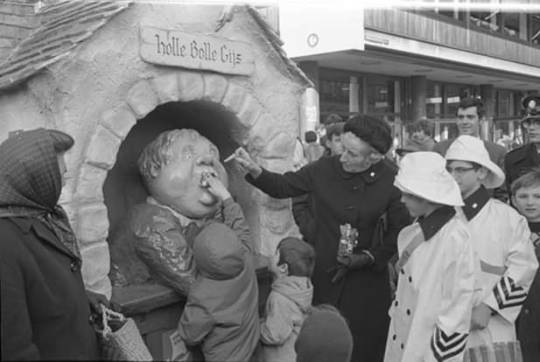
0 notes
Photo



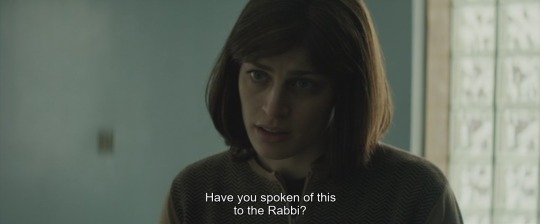
Félix et Meira (Maxime Giroux - 2014)
#Félix et Meira#Maxime Giroux#Canadian drama film#Canadian cinema#Canadian drama movie#Canadian movies#cinema#Quebec#movies#2010s cinema#2010s movies#Canadian society#2010s#Canada#Martin Dubreuil#Luzer Twersky#Hadas Yaron#Montreal#Jewish family#Hassidic Jewish#French Canadian people#Hassidic community#Yiddish
2 notes
·
View notes
Text
Remy Martin celebrates collective success through its new global campaign
Remy Martin unveils “Team Up For Excellence”, a celebration of collaboration, shared values, and the success it generates, created by the Fred & Farid Paris agency
Remy Martin, a producer of cognac, has launched a new platform that reflects its values of authenticity, audacity and generosity. Named “Team up for excellence,” the campaign draws from these to pay homage to personal success through the various people who made it possible.
Remy Martin’s philosophy of expert cognac making is a result many talents working together under the aegis of Baptiste Loiseau, the House’s Cellar Master; just like a conductor, he coordinates the various steps of cognac elaboration: winegrowing, vinification, distillation, blending and ageing.
The House of Remy Martin is a story of family, partners and collective success: André Hériard Dubreuil and André Renaud, Baptiste Loiseau and Pierrette Trichet, to name just a few. Over the years, teamwork has been at the heart of The House of Remy Martin. It is a value close to the ethos of the brand, especially the younger generations: a need to be a part of a group and a desire to collaborate or co-create.
Since 1724, the celebrated cognac House has been rooted in exception, producing cognac from both the Grande and Petite Champagne regions of France. Since 1966, Remy Martin has had a contractual association, a multi-year partnership between the merchant and the winegrower, that formed the Alliance Fine Champagne.
Notable guests included former Victor Cruz, Jermaine Dupri, Tamra Simmons, Murda Beatz, amongst others.
This quest of excellence has been the Remy Martin trademark since 1724, a brand with the constant dedication of creating quality cognac. To continually achieve higher and further as a reflection of the Centaur, the brand’s figurehead for 150 years.
At the core of this new campaign, two films were conceived by the Fred & Farid Paris agency and directed by Vellas, a Brazilian director chosen by the brand for his aesthetic and his ability to tell a well-paced, authentic and emotive story. These works reflect the contemporary idea of creating shared success.
The first film dedicated to Remy Martin’s expertise shows masters of the Remy Martin Estate for the first time: Baptiste Loiseau (Cellar Master), Laura Mornet (Viticulture Consulting Manager), Julien Georget (Estates Manager) and Michael Meunier (Cooperage Manager) all took part. The film delivers a sensory experience through an ingeniously choreographed sequence which connects the various stages of the cognac-making process.
“It is a wonderful project which was made through teamwork. The result is a film which shows the essence of our trades, the passion which bonds us together and drives us, and above all the evidence of working together for the better, the excellence of our cognac”, commented Baptiste Loiseau, The Cellar Master.
youtube
The second film entitled “Start-up” takes place in the vibrant world of young, pioneering companies. It celebrates synergy, collective emulation around an original idea which will gradually come to fruition.
The new campaign draws on the rich, nearly 300-year history of Remy Martin, whilst remaining entirely contemporary. “Team up for excellence” emphasises the superiority of Remy Martin cognac with its greatest asset: Fine Champagne, the foundation stone of the House’s global reach.
“Remy Martin is more than just a brand. It is a constellation of talent-driven by that rarely-found feeling of belonging to a real family”, stresses Augustin Depardon, Global Executive Director of Remy Martin.
The campaign was launched with a celebration in Versailles, France, on October 21, 2019, which brought together one hundred guests who contributed to the success of the brand around the world and share the same uncompromising commitment to achieving excellence through collaboration in their respective arts. Notable guests included former Victor Cruz, Jermaine Dupri, Tamra Simmons, Murda Beatz, amongst others.
The article Remy Martin celebrates collective success through its new global campaign appeared first on World Branding Forum.
0 notes
Photo
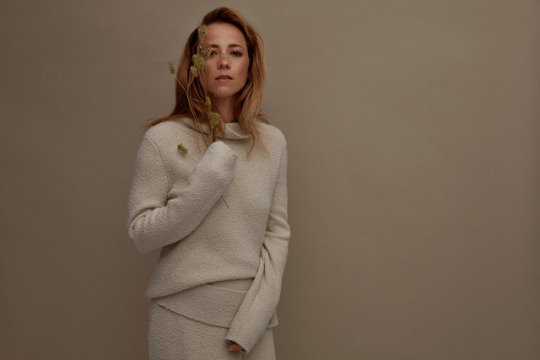



MAXYME G. DELISLE / MAGAZINE M+XY / KARINE VANASSE ET JEAN-SIMON LEDUC / 2017
“Le défi dans les séances de portraits, c’est d’amener le sujet ailleurs sans le dénaturer.”
- Maxyme G. Delisle
Crédits :
Rédacteur en chef : Martin Beauséjour
Directeur Artistique : Martin Moreau
Photographe : Maxyme G. Delisle
Assistant : Marc-Antoine Dubois
Styliste : Marianne Dubreuil
Mise en beauté : Julie Cusson
1 note
·
View note


